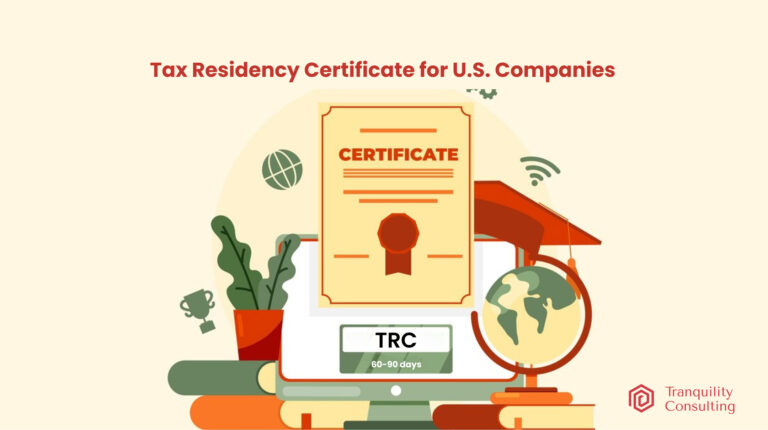Tax Residency Certificate (TRC) is an essential document for individuals and businesses who wish to claim benefits under the Double Taxation Avoidance Agreement (DTAA) between the U.S. and another country. TRC helps establish the residency of an individual or entity in a particular country, confirming their eligibility for tax relief under the DTAA. Obtaining a TRC from the U.S. can help avoid double taxation on income, making it a critical step for anyone engaged in cross-border business or investment.
Benefits of a TRC in the U.S.
- Avoid Double Taxation: The primary advantage is claiming relief under the DTAA. Without this certificate, taxpayers might be subject to taxation in both countries where they earn income.
- Reduced Tax Liability: Depending on the DTAA, you may qualify for reduced or exempt tax on income types like interest, dividends, royalties, and capital gains.
- Credibility for Businesses: A TRC enhances the credibility of U.S. businesses operating internationally, ensuring they comply with U.S. tax laws and foreign regulations.
- Claiming Foreign Tax Credits: A TRC allows taxpayers to claim foreign tax credits, ensuring they do not pay more than they owe in the U.S. and abroad.
- Better Tax Planning: For both individuals and businesses, a TRC provides clarity on residency, allowing for more effective tax planning and resource allocation.
Who Can Request a TRC??
Individuals or entities that want to claim tax benefits under the Double Taxation Avoidance Agreement (DTAA) need to file for a TRC. This includes:
- U.S. Citizens Living Abroad: U.S. citizens or residents who earn income in a foreign country and wish to avoid double taxation must apply for a TRC. This includes expatriates, freelancers, or U.S. companies operating overseas.
- Foreign Investors in the U.S.: Non-U.S. citizens or entities that invest or earn income in the U.S. and want to avoid double taxation must also file for a U.S. TRC.
- Businesses with Global Operations: U.S. businesses that operate in foreign countries need a TRC to claim benefits under the DTAA. This applies to multinational corporations, partnerships, and other entities involved in cross-border transactions.
- Non-Resident Aliens: Foreign nationals who earn U.S. income but reside in a country with a tax treaty with the U.S. need a TRC to enjoy treaty benefits, such as reduced tax rates on dividends, interest, or royalties.
How Many Days Does it Take to Get a TRC Form?
Obtaining a Tax Residency Certificate (TRC) in the U.S. typically takes around 60-90 Days. However, this timeline may vary depending on several factors, including the complexity of the case and the responsiveness of the applicant. To get a U.S. TRC, applicants generally need to submit IRS Form 8802, “Application for United States Residency Certification.”
Here is a step-by-step breakdown:
- Prepare Required Documents: Gather all necessary documents, including proof of residency and past tax returns. You may also need to submit additional documents to prove your residency in the U.S.
- Complete IRS Form 8802: Fill out the form accurately. Incomplete or inaccurate applications can delay the process.
- Submit the Application: Submit Form 8802 along with any required supporting documents and pay the applicable fee.
- Processing Time: The IRS takes 60-90 Days to process TRC applications. It’s crucial to apply well in advance, particularly if you need the certificate to claim treaty benefits on a specific transaction.
How to Apply for a TRC
Obtaining a U.S. TRC involves submitting IRS Form 8802 (“Application for United States Residency Certification”).
Here’s a step-by-step guide to the application process:
- Prepare Necessary Documents: Ensure you have all required documentation, such as proof of U.S. residency and tax filings from previous years.
- Complete IRS Form 8802: Fill out this form accurately. Incorrect or incomplete forms can delay the application.
- Submit the Form and Pay the Fee: The current IRS fee for filing Form 8802 is $85. This amount may change, so it’s essential to check the latest fee schedule on the IRS website.
- Processing Time: The IRS typically takes 60-90 days to process TRC applications. In case of delays beyond 90 days, you can contact the IRS at 1-267-941-1000 for assistance.
Challenges in Obtaining a TRC
Although obtaining a TRC in the U.S. is generally straightforward, several challenges can arise:
- Incomplete Documentation: One of the most common issues is submitting incomplete or incorrect documentation. The IRS is strict about the requirements, and any missing or inaccurate information can delay the approval of the TRC.
- Delays in Processing: The standard processing time of 60-90 days can sometimes extend due to IRS backlog or errors in the application. Applicants are encouraged to apply well in advance.
- Complicated Filing for Businesses: Businesses, especially multinational corporations, may face more complex filing requirements due to multiple tax jurisdictions, partnerships, or other complex legal structures.
- Maintaining Residency Status: To renew the TRC annually, taxpayers must continue to prove that they meet U.S. residency requirements, which can become challenging if their residency status changes.
Renewal of TRC Form Every Year
A Tax Residency Certificate (TRC) is usually valid for 1 year. After that, individuals and businesses must apply for its renewal to continue benefiting from the tax relief provisions of the DTAA. The renewal process is similar to the initial application and requires the submission of updated documents, such as financial statements, residency proof, and any other country-specific forms like orm 8802. The renewal should ideally be initiated well in advance to avoid lapses in coverage.
Conclusion
A Tax Residency Certificate (TRC) ensures compliance with international tax laws and avoids double taxation. Whether you are an individual or a business, obtaining and renewing your TRC is essential for taking advantage of the DTAA benefits, reducing tax liability, and maintaining tax efficiency in cross-border transactions. However, documentation requirements, verification delays, and renewal challenges can complicate the process. Consulting with experts, such as Tranquility Consulting, can help streamline the process and ensure you make the most of the available tax relief benefits.
FAQs
- What is a Tax Residency Certificate (TRC)?
A TRC is a document that proves the residency of an individual or entity for tax purposes, allowing them to claim tax benefits under a tax treaty.
- Who needs to apply for a TRC?
U.S. citizens living abroad, foreign investors in the U.S., businesses with international operations, and non-resident aliens earning U.S. income.
- How long does it take to get a TRC in the U.S.?
The processing time for a TRC typically takes 60-90 days, depending on the completeness of the application.
- How can Tranquility Consulting help with the TRC application process?
Tranquility Consulting offers expert support in filing IRS Form 8802, gathering the required documentation, and assisting with TRC renewals, ensuring compliance with tax laws.
5. How much is the fee for filing Form 8802 to obtain a TRC?
The current fee for filing IRS Form 8802 (Application for United States Residency Certification) is $185. Applicants should check the IRS website for any updates on fees before filing.
If you have any questions or need business-related tax consulting advice, please contact us at: [email protected]





